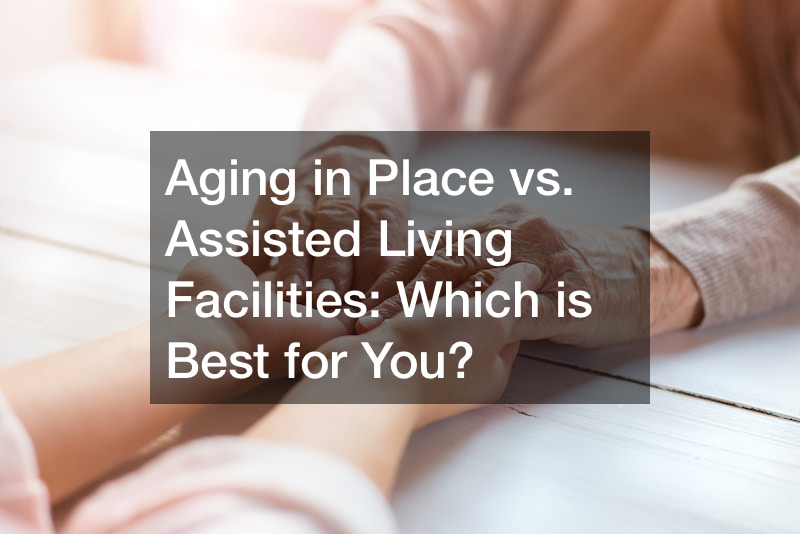While evaluating long-term care options, many seniors and their families must make the decision of aging in place vs assisted living facilities. In this guide, we explore the two options, what they involve, and the factors to consider. We dig deeper into the unique advantages and drawbacks each option offers. We hope that, in the end, you’ll have made the challenging decision on which is best for you or your loved one. Let’s dive in.
Aging in Place
The idea of ‘aging in place’ refers to seniors opting to stay in their own homes and communities as they get older, rather than moving to assisted living facilities or nursing homes. It represents the concept that one may mature gracefully and happily in similar settings that they have treasured their entire life. ‘There’s no place like home,’ as the phrase goes, embodies the essence of aging in place, emphasizing the emotional commitment and sense of belonging that people have to their own homes. It’s a compelling alternative when comparing the dynamics of aging in place vs assisted living. But is it for you? Here are the benefits and disadvantages of aging in place.
Benefits of Aging in Place
Aging in place provides various advantages for seniors who want to age in their own homes rather than move to assisted living facilities. This choice promotes a sense of familiarity and emotional well-being, which leads to a greater quality of life. According to the AARP, approximately 77% of seniors want to stay in their present homes as long as feasible. Let’s look at the specific benefits of aging in place and how they might benefit seniors and their families.

Embracing Independence and Familiarity
The ability to keep independence and control over daily routines and activities is the key advantage of aging in place. Seniors make decisions about their own lives while still feeling autonomous and self-determined. You’ll continue to live according to your own schedules and preferences, rather than the regimented setting of an assisted living facility. This amount of freedom may significantly improve one’s emotional well-being and general happiness. A major factor when considering aging in place vs assisted living.
Personalized Medical Support
For seniors who choose aging in place, the ability to receive personalized primary care services is a significant advantage. Seniors can continue their relationship with their trusted primary care physician, who understands their medical history and unique healthcare needs. With regular visits, the primary care physician monitors their health, provides preventive care, and manages chronic conditions effectively. This continuity of care is particularly beneficial for seniors with complex medical needs and requires ongoing support from a familiar healthcare provider.
Legal Support
Aging in place vs assisted living: For individuals with specific legal concerns, such as estate planning or advanced directives, aging in place offers the advantage of easily engaging with an attorney. Seniors can consult with an attorney to create wills, establish powers of attorney, or set up trusts to ensure their wishes are followed in the future. Having access to personalized legal expertise can provide peace of mind and ensure that important legal matters are addressed according to the senior’s preferences and best interests.
Familiar and Supportive Environment
Aging in place can also be beneficial, especially for individuals with dementia or cognitive impairments. Consider the senior’s health condition when choosing between aging in place vs assisted living. By remaining in a familiar environment, seniors with dementia experience a greater sense of security and comfort. The consistency of their surroundings and routines can help reduce confusion and agitation. With appropriate support, including in-home caregivers or specialized dementia care services, seniors with dementia can receive the necessary assistance while still enjoying the comforts of their own homes.
Drawbacks of Aging in Place
While aging in place has advantages, it also has certain downsides when compared to supported living. To make an informed selection between aging in place vs assisted living, it’s important to consider these points. The primary drawbacks of aging in place are as follows.
Limited Access to Specialized Healthcare and Support Services
One of the challenges associated with aging in place is the potential difficulty in obtaining adequate healthcare and support services. Seniors who prefer to age in place may confront challenges in terms of access to specialist medical care, particularly in rural or distant places. Coordination of in-home care services, such as nursing or therapy, may be difficult and time-consuming.

Financial Burden of Remodels
Aging in place often involves home modifications to improve accessibility and safety, but these modifications can come with a significant financial burden. Remodeling a home to accommodate aging needs, such as installing grab bars or ramps, can be costly. According to recent studies, an aging in place remodel can range from $10,000 to $100,000, depending on the extent of modifications required.
Legal Complexities and Estate Planning
Seniors who age in place may encounter challenges related to legal matters and estate planning. Engaging with an estate attorney is vital for drafting wills, establishing trusts, or creating power of attorney documents. However, the costs and complexities of legal procedures and requirements can be overwhelming for seniors and their families, and it’s important to seek professional advice to ensure that the necessary legal documents are prepared accurately.
Social Isolation and Limited Social Interaction
Another drawback of aging in place is that it may lead to social isolation and limited opportunities for social interaction. Seniors who choose to remain at home aging in place vs assisted living may face decreased social engagement due to reduced mobility, lack of transportation options, or a shrinking social network. This can result in loneliness and negatively impact physical and mental health. Assisted living facilities, on the other hand, provide a built-in community and a range of social activities and programs to combat social isolation.
Assisted Living
Assisted living is a type of residential home for seniors who need help with everyday tasks and have access to supportive services. Assisted living facilities, as opposed to aging in place, where people stay in their own homes, offer a communal atmosphere with varied degrees of care. They provide assistance with chores such as medication administration, personal care, and cleaning, as well as social and recreational activities. When deciding between aging in place vs supported living, assisted living offers a supportive environment as well as professional care workers, making it a distinct option.
Benefits of Assisted Living
Assisted living offers several benefits for seniors seeking a supportive and engaging living environment. This section highlights the key advantages of assisted living. Here we go!
Access to Professionals
Assisted Living Facilities prioritize the well-being of their residents by providing comprehensive healthcare support. Residents have access to a team of healthcare professionals, including doctors, nurses, and specialists like a chiropractor. These specialists are readily available to address seniors’ medical needs promptly and effectively.
Most assisted living communities also offer an on-site or affiliated orthopedic clinic, which specializes in musculoskeletal care. This ensures that seniors receive specialized orthopedic treatments, assessments, and rehabilitation services conveniently within their living environment. A great consideration while choosing between aging in place vs assisted living.
Enhanced Safety and Security Measures
Assisted living facilities place a strong emphasis on ensuring the safety and security of their residents. These communities are equipped with various safety features such as emergency call systems, round-the-clock staff availability, and secure access control. These measures provide peace of mind to both residents and their families, knowing that there is a support system in place to address emergencies and maintain a secure living environment. The enhanced safety measures implemented in assisted living communities help prevent accidents and provide a sense of security for seniors.

Companionship and Social Engagement
Another significant advantage of assisted living is the opportunity for residents to experience caring companionship and engage socially within a community setting. Assisted living facilities foster an environment where residents can interact with their peers, participate in communal activities, and form meaningful relationships. This social engagement plays a vital role in combating feelings of loneliness and isolation commonly experienced when aging in place. The sense of community and companionship contribute to emotional well-being and overall quality of life for seniors.
Access to Recreational and Enrichment Programs
Assisted living communities offer a wide array of recreational and enrichment programs that enhance the residents’ quality of life. These programs encompass various activities such as fitness classes, arts and crafts, educational workshops, outings, and cultural events. Aging in place vs assisted living: Assisted living provides a diverse range of activities, and communities cater to the different interests and abilities of their residents, allowing them to pursue their passions and discover new hobbies. Engaging in such programs promotes an active and fulfilling lifestyle, leading to personal growth and enjoyment.
Drawbacks of Assisted Living
Assisted living isn’t without disadvantages, it’s important to consider the potential drawbacks associated with this living arrangement. Understanding these drawbacks will help you make well-informed decisions. Weigh these factors against the benefits to determine the best fit for your individual needs and preferences.
Loss of Independence and Privacy
One of the main disadvantages of assisted living in aging in place vs assisted living is the potential loss of independence and privacy. While assisted living facilities aim to provide support, some individuals may feel a diminished sense of control over their daily lives. The structured environment and assistance from staff members may require residents to adapt to a new routine, which can be challenging for those accustomed to making their own decisions. Furthermore, living in a communal setting means sharing living spaces and facilities with others, which may compromise the level of privacy one desires.
Costs and Insurance Coverage
The related expenditures and insurance coverage are another downside of assisted living. The expenses of assisted living vary greatly based on location, services provided, and individual needs. The cost of assisted living can be much greater than the cost of aging in place, particularly when monthly fees, additional costs for specialized care, and possible price increases over time are included.
While life insurance can offer financial security, it may not cover all of the costs involved with assisted living, putting individuals and their families on the hook for additional fees. As a result, before committing to assisted living, it’s important to thoroughly examine the financial consequences and investigate various insurance possibilities.

Limited Legal Support
Access to legal support, including a disability lawyer, may be limited within the context of assisted living. While these facilities may have some resources available, they may not provide the same level of comprehensive legal assistance as one would have access to when aging in place. Individuals may need to seek external legal counsel for matters related to disability rights, benefits, or other legal issues. Consider the availability of legal support when deciding between aging in place vs assisted living, especially for those who require specific legal guidance and representation.
Making The Right Decision
Before making the challenging decision between aging in place vs assisted living, consider your healthcare needs, financial situation, and social well-being. Assess the availability of necessary services, compare the costs of both options and evaluate your preference for independence or community engagement. Recognize that this decision can be difficult, and seek advice from healthcare professionals, financial advisors, and loved ones to make an informed choice.
In conclusion, the choice between aging in place vs assisted living is a deeply personal one that should be based on individual needs, preferences, and circumstances. Aging in place allows for familiarity and independence, but may require additional support and modifications. On the other hand, assisted living offers professional care, a supportive community, and peace of mind, but may involve a transition and financial considerations. Carefully weigh the advantages and disadvantages of each option and consider factors such as healthcare needs, financial stability, and social well-being.


